Sony's 24.3 MP Exmor APS HD CMOS sensor combined with a versatile E-mount interchangeable lens system enables the camera to take images of the astounding quality. Fast hybrid autofocus system allows capturing every subject clearly with unparalleled precision in record time.
The video recording button is placed somewhat inconveniently.
You will not miss an important moment and will be able to easily make a successful shot with this camera. The model is very handy and all of the controls are fairly ergonomic, which increases the comfort levels during the shooting process.
Electronic
3.0" TFT LCD
24.3 MP, APS-C, "Exmor®" CMOS
100-25600 (extended to 51200)
16-50 mm, f/3.5-5.6 OSS, E-Mount
JPEG, RAW, RAW+JPEG
Photos: up to 6000x4000 (3:2)
Videos: up to 1920x1080 (60p/60i)
11 fps
Photos - up to 360 frames
Videos - up to 90 min
Rechargeable battery pack, AC adapter, Eyepiece cup, Lens cap, Micro USB cable, Power cord, Standard lens, Shoulder strap
1 year
The new APS-C X-Trans ™ * CMOS II sensor generates close to no noise at high ISO values, allowing you to take high-quality pictures in low light without having to use a flash. Balanced handling and grip are useful when it comes to shooting with some additional comfort.
Slow camera start after standby mode.
The mirrorless X-T10 camera is one of the best options for those who want to have a high-quality, technologically impressive, and compact camera with the most advanced features. Several customisable buttons give you quick access to frequently used functions, allowing you not to waste time setting up the camera and focus on the object instead.
Electronic
3.0" Tilt type LCD monitor
16 MP, APS-C X-Trans CMOS II sensor
200-6400 (extended to 51200)
FUJIFILM X mount
JPEG, RAW, RAW+JPEG
Photos: up to 4896 x 3264 (3:2)
Videos: up to 1920 x 1080 (60p)
8 fps
Photos - up to 350 frames
Videos - up to 124 min
Li-ion battery NP-W126, Battery charger BC-W126, Shoulder strap, Body cap, Metal strap clip, Protective cover, Clip attaching tool
1 year
Photos: up to 6000x4000 (3:2)
Videos: up to 1920x1080 (30p)
Photos - up to 250 frames
Videos - up to 100 min
The model in question boasts an incredibly fast serial shooting feature that reaches up to 20 frames per second utilising the autofocus option. The adapter allows you to connect to the model "F" lenses, which are used on conventional SLR cameras.
The package does not include a so-called "hot shoe".
This Nikon model provides plenty of opportunities not only for beginners but also for experienced enthusiasts. The ergonomic aspect was improved and the housing was redesigned compared to the previous generation. J5 gives its owner the opportunity to shoot videos in 4K. This is a compact camera for a reasonable price.
No, Live View via LCD screen
3.0" LCD touch screen, tilt-type (180° up / 86° down)
20.8 MP, CMOS, Nikon CX
160-6400 (extended to 12800)
Nikon 1 mount
JPEG, RAW, RAW+JPEG
Photos: 5568 x 3712 (3:2)
Videos: 3840 x 2160 (15p), 1920 x 1080 (60p)
20 fps
Photos - up to 250 frames
Videos - up to 60 min
Nikon 1 J5 Compact System Camera, EN-EL24 Rechargeable Li-ion battery, MH-31 Battery charger with UK plug, BF-N1000 Body cap, UC-E20 USB cable, AN-N1000 Neck Strap, View NX 2/Short Movie Creator Software
1 year
The model features one of the fastest and most accurate single autofocus options among the models in its class. it also includes built-in Art Filters, which will immediately edit the photo and a Live Guide that provides comprehensive information about each function of the new camera.
There is no "PASM" feature which complicates the use of the camera.
Olympus Pen E-PM2 is a simplified version of the OM-D line of cameras with the same image quality but in a lightweight and more compact housing. The model delivers excellent colours and exposure when it comes to JPEG shooting and provides easy control with the help of just a few buttons and a navigation wheel.
Optional (Olympus VF-2/3/4)
3.0″ LCD touch screen
16.1 MP, 4/3", Live MOS
200-25600
14-42mm, f/3.5-5.6, Micro Four Thirds lens mount
JPEG, RAW, RAW+JPEG
Photos: 4608 x 3456 (3:2)
Videos: 1920 x 1080 (30p)
8 fps
Photos - up to 360 frames
Olympus E-PM2 body, M.ZUIKO Digital 14 -42mm II R lens, FL-LM1 flash, BLS-5 Li-ion battery, BCS-5 Li-ion battery charger, USB cable, AV cable, Shoulder strap, OLYMPUS Viewer 2 (CD-ROM)
1 year
This site is a free online resource that strives to offer helpful content and comparison features to its visitors. Please be advised that the operator of this site accepts advertising compensation from certain companies that appear on the site, and such compensation impacts the location and order in which the companies (and/or their products) are presented, and in some cases may also impact the scoring that is assigned to them. The scoring that appears on this site is determined by the site operator in its sole discretion, and should NOT be relied upon for accuracy purposes. In fact, Company/product listings on this page DO NOT imply endorsement by the site operator. Except as expressly set forth in our Terms of Use, all representations and warranties regarding the information presented on this page are disclaimed. The information which appears on this site is subject to change at any time. More info
Sony ILCE6000LB
Japanese Performance
Sony is a Japanese transnational corporation headquartered in Tokyo, formed on May 7, 1946, that specialises in the production of home and professional electronics, gaming consoles, and other high-tech products. Sony is one of the world's largest media conglomerates, owning the record label of Sony Music Entertainment, the Columbia Pictures studios, and TriStar Pictures, as well as a full archive of MGM films (in conjunction with Comcast). So buying any piece of electronics from this company, you know full well that you're getting a quality piece of technology.
This Sony camera model features some major changes that are related to the sensor. The new 24 megapixel 'Exmor APS HD' CMOS sensor has on-chip phase detection similar to its predecessor, but it covers a much larger area of the frame. This model has better AF tracking which is noticeable when you are shooting continuous shots. This device's image processor is Bionz X with improved detailing and smart noise reduction.
The Sony model in question stands out from similar models due to Hybrid AF System. 25-point contrast detect stays the same compared to the previous generation but the number of phase-detect points has grown from 99 to 179 which means you can track objects in a much wider area.
Going back to the Bionz X Processor, this is a more powerful version than the one used in previous models thus providing the user with a more refined performance. Moreover, this processor promises "Diffraction Reduction", which means correcting the mildness caused by diffraction. The context-sensitive is more advanced now with noise reduction becoming area-specific. The camera delivers smooth tones and is capable of concentrating on the object's edges.
This device comes equipped with two Auto ISO modes: traditional mode and complicated one ( JPEG-only mode), which shoots 3 pictures and combines them together in order to reduce noise. The owner can set a desirable aperture and shutter speed, and the camera changes the ISO to correct exposure (all while giving control over the brightness of the image).
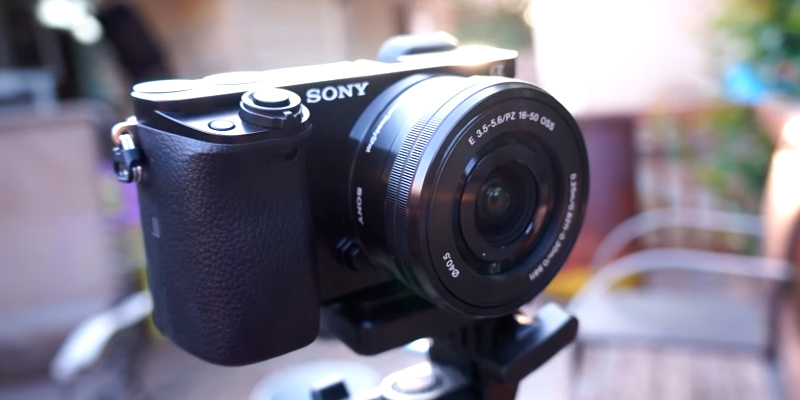
Astounding Quality
This model has a tilting LCD with 921,600 pixels resolution and an aspect ratio of 16:9, which is great for both video and photo shooting. This camera's Wi-Fi system means the device can be easily controlled remotely via the user's smartphone. And if your phone is equipped with NFC, you don't have to bother with Wi-Fi, just bring the devices close to each other. The brand new Sony characteristic is the ability to monitor this mirrorless camera through your Mac or PC.
The matrix provides correct colour reproduction while preserving the details, but, of course, utilising only high-quality optics. But if you want to increase the results, it is necessary to choose the correct colour and white balance settings.
The system of automatic focusing is delightful. 179 phase sensors cover 92% of the frame, missing only the extreme points of the corners. The speed of aiming is amazingly high even in bad lighting conditions. The tracking system notes even fast moving objects and watches them very closely. Also, the automatic focusing system works during video recording.
This camera records video in standard 24/25/30/50/60p Full HD in AVCHD and MP4 delivering a considerable level of quality. Although the autofocusing system that can operate during recording is an undeniable plus, you still need to understand what exactly you want to shoot, because some scenes are much easier to capture with your own two hands without using this useful feature.
So, this is an amazing ergonomic camera with low-noise matrix and good autofocus (even in video mode) and it is undoubtedly one of the best professional mirrorless cameras out there. Wi-Fi and NFC options make it modern enough to meet any user's requirements.

Additional Info
| Last updated price | £481.09 |
| Stock | In stock |
| ASIN | B00IE9XHE0 |
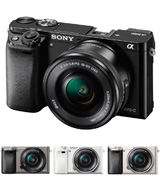
Fujifilm X-T10
Experience in the Industry
Fujifilm Holdings Corporation is a well-known Japanese manufacturer of cameras and one of the world's largest manufacturer of photographic products, which has laboratories, factories, and representative offices in Asia, Europe, and North America.
Fujifilm X-T10 design is that of a contemporary classic. It looks like the cameras of the tape era, but it is successfully supplemented with the newest controls and features. The housing of the device is made of magnesium alloy which greatly affects the tactile sensations. The metal construction adds X-T10 durability but does not increase the weight. Also, T-X10 dimensions present a considerable advantage, too. The width, height, and thickness are 118.4 mm, 82.8 mm and 40.8 mm accordingly. There are two options for the colour design: silver and black. Shooting while holding the camera with a single hand is possible without worrying about losing a grip. Of course, Fujifilm also offers an accessory grip if you do not feel comfortable taking pictures without it.
We've got to talk about the controls of this small mirrorless camera. There are three dials to maximise the operational settings of the shooting parameters - exposure compensation dial (in the range -3 to +3 EV in increments of ⅓ step), controls shutter speed (from 1 sec to 1/4000 sec) and the drive mode dial (for the operative selection of the shutter mode and special shooting modes).

Special Features
X-T10 camera features the X-Trans CMOS II sensor with a resolution of 16.3 megapixels as a photosensitive element. The sensor in question is one of Fujifilm's own technologies. Its peculiarity relies on the atypical location of coloured elements, different from the standard "Bayer" model. It is the X-Trans-sensor that is responsible for the amazing and special colour rendering that makes Fujifilm cameras different from a myriad of competitors. Moreover, the X-T10 matrix comes equipped with the phase detection pixels, the presence of which should positively affect the speed and accuracy of focusing. This camera is featured with a digital viewfinder on the external display, which is endowed with an inclined design. This feature is useful when the shooting point happens to be very low. The diagonal of the screen is 3 ", the resolution is 920,000, the aspect ratio is 3: 2.
It's hard to surprise anyone with a camera supplied with a video recording function nowadays, so video mode is not a big surprise, but the quality of it definitely manages to stand out, recording in Full HD with a resolution of 1920 x 1080 and a frequency of 60p, 50p, 30p, 25p, and 24p. Unfortunately, the headphone jack is not featured in the Fujifilm X-T10 but there is a jack for connecting an external microphone. Its diameter is slightly different from the most common 3.5 mm (mini-jack) and is 2.5 mm. However, it is easy to find adapters that solve this problem.
This Fujifilm camera fits professionals just as good as it does amateurs and it is definitely worth its price.
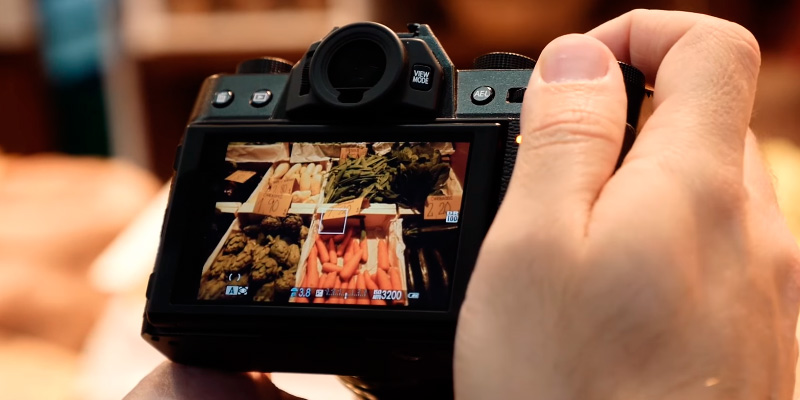
Additional Info
| Last updated price | £349.88 |
| Stock | In stock |
| ASIN | B00XW6936Q |
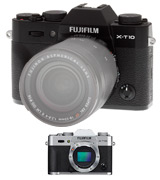
Canon EOS M3
From an Amateur…
The Canon company was founded in 1937 and it took 50 years (1987) to launch its first DSLR camera Canon EOS 650. For many years a single-lens reflex system was an inalienable attribute of the professional-grade cameras produced by the company and it was not until 2012 that Canon management took a decision to launch the EOS M line of mirrorless cameras. One of these devices we are going to focus on in this review.
The EOS M3 mirrorless camera is equipped with an APS-C image sensor with a 24.2 Megapixel general resolution. The highest light sensitivity level supported by the sensor conforms to ISO 12800, though it can be increased to 25600 to prevent you from missing an important shot even in poor lighting. In case you are striving for even more quality shots, the continuous shooting in RAW format at the rate of 4.2 frames per second will help you succeed. While this frame rate is not the highest one in comparison to other modern mirrorless cameras it proved to be sufficient for most amateur users. The EOS M3 is known for its improved focusing with the Hybrid CMOS AF III system comprising 49 sensors distributed along the frame. These improvements allow for increasing the focusing speed more than 6 times in comparison to the camera predecessors. It is notable that the Hybrid CMOS AF III system performs in full even when you make a video footage contouring a subject with red lines, which is very convenient especially in a bright light that may make the display hard-to-read. The optical zoom of this Canon mirrorless camera is realized with a standard lens with 18-55 mm focus length, which is probably a happy middle ground for amateur photographers enabling them to take both expressive portrait photos and stunning landscape pictures. Anyway, if you feel the included lens doesn't perform good enough, you can purchase another lens model compatible with the lens mount of the EF-M.

...to a Professional
Those who do not like to use an eyepiece when taking pictures will be pleased as this mirrorless camera by Canon has none. But do not take it wrong – the choice of such a design has not in any way impaired the functionality of the EOS M3 while the price of the device lowered. The use of a viewfinder with an eyepiece is still provided for, thus can be used after purchasing separately if you wish. However, the first thing we noticed about the camera exterior is the Exposure Compensation Dial, which is conveniently placed on the camera upper side. This dial facilitates the exposure adjustment dramatically when taking stills, thereby making this model compete with much higher priced DSLR cameras of a professional tier and evidencing about the company engineers taking the model development seriously. Continuing the controls examination it is worth noting that there is a tiltable touch screen at your service. With that, tilting the display down was not that impressive but the ability to tilt it 180° upward was very much to our liking. This feature opens the door to a world of exciting self-portrait photographs or selfies, the quality of which is far beyond the reach of any smartphone camera.
Talking about the shooting modes, this EOS M3 mirrorless camera has to offer a couple of interesting modes – Creative Assist and Creative Filters mode along with the manual one for shooting video footages. Using one of these creative modes you can select among the predefined effects on the fly to finalize the images and omit their further post processing on a PC. The manual video shooting mode enables you to adjust the exposure, diaphragm or ISO light sensitivity settings in real time to improve the quality of shooting. Concerning the video shooting with this mirrorless digital camera the Canon engineers took a holistic approach to ensuring a good quality of footages by means of making it possible for a user not only to achieve a high-quality video but also a decent sound quality by connecting an external mic to the Canon EOS M3 via the 3.5 mm mini jack.
To conclude, we came across the Canon camera, which is capable of taking high-quality stills and even shooting videos when being held at almost any angle to a user, including the angles for selfies. The camera is suitable for both beginners and professionals, with the intelligent focusing system as an assistant for amateurs and the advanced settings for professionals to adjust an image quality on the fly.

Additional Info
| Last updated price | £321.38 |
| Stock | In stock |
| ASIN | B01LOCDD3S |

Nikon 1 J5
Outstanding Accuracy
Nikon Corporation is a Japanese company, which is famous for manufacturing of optics and electronic devices for image processing. Nowadays the company has been restructured into four divisions: photographic equipment and photo accessories, precise equipment (the production of systems for the manufacture of microcircuits and LCD screens), tools (production of industrial microscopes and measuring equipment), and other fields (mostly different kinds of medical equipment). But despite all of these divisions, Nikon is still associated first and foremost with quality cameras and the particular model in question sticks to that tradition.
Nikon 1 J5 is an amateur mirrorless camera for those who have already outgrown their smartphones and are striving for better image quality but don't want to invest in some of the more expensive equipment just yet. This small mirrorless camera may seem somewhat simple but it absolutely delivers where it most counts. The combination of a minimalistic design, powerful specifications, and a necessary set of functions in a tiny housing presents a sufficient amount of good reasons to call the J5 a great camera for everyday shooting and an alternative to budget DSLR cameras.
Currently, the J5 has the highest resolution from the entire Nikon 1 line, allowing you to take pictures in 5568 x 3712 pixels with a 3:2 format. Moreover, the sensor is manufactured with backlighting technology, which is an advantage when it comes to shooting in low light conditions. The lack of a smoothing filter in the sensor is also a pleasant feature that allows the user to avoid low detailing.
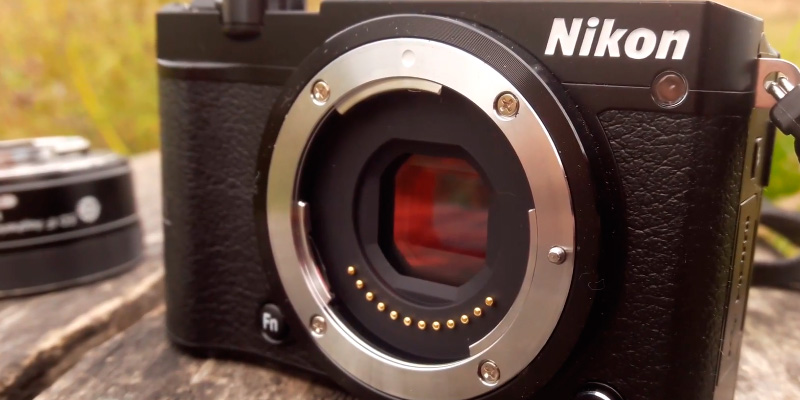
Best for Amateurs
The new generation processor Expeed 5A improves the images with both low and high ISO values - up to 12800. Besides, this small and compact mirrorless camera has an impressive speed of serial shooting - 60 frames per second with a fixed autofocus. With the permanent autofocus, the rate of the shooting decreases to 20 frames per second, which, however, is still a very good rate. The new processor has expanded the possibility of video shooting - now Nikon 1 J5 is able to record videos in a 4K format. Though the camera does it with a frequency of only 15 frames per second. The camera also supports time-lapse shooting up to 300 photos with the ability to set time intervals. All in all, this is one of the best contenders for a title of the best mirrorless camera for video.
One of the main advantages of the Nikon 1 J5 is a large 3-inch display on the rear side of the housing. It has a resolution of 1,037,000 pixels and a rotary function. The display is able to rotate 180 degrees to capture selfies (the mode is automatically activated in this position) and it is also convenient to fold for shooting with arms stretched out. The screen supports touch control which is very useful for quick focus and quick access to shooting parameters. Support of the Multitouch function provides the opportunity to enlarge the image on the screen by touching it with two fingers, as well as flipping the pictures without using any of the buttons. Furthermore, a hybrid autofocus system is implemented in this compact mirrorless camera. When you use a single-point focusing mode, you will have 171 focus areas, of which 105 central ones support phase detection, and the rest - contrast detection. With the automatic selection of the autofocus zone, the available number is only 41.
In conclusion, this is one of the best beginner mirrorless cameras on the current market and its price is fairly low given the outstanding specs it comes with.

Additional Info
| Last updated price | £200.00 |
| Stock | In stock |
| ASIN | B00VFLZ15M |
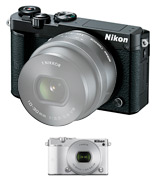
Olympus Pen E-PM2
Expert in Optics
Olympus Corporation is another well-respected and renowned Japanese manufacturer of optics, photographic equipment, high-quality optical equipment for medical and biological research, and other technical solutions. The company expanded its "mirrorless" line with OM-D, E-M5, PEN E-PL5 and PEN E-PM2 devices in 2012. The updated PENs are equipped with the same new Live MOS sensor with a resolution of 16.1 megapixels and a TruePic VI processor. E-PM2 is available in black, silver, white, and red colours.
One of the best things about the model in question, Olympus Pen E-PM2, is its housing that stands out in terms of convenience. The display is rather user-friendly when it comes to both the settings of the device and the shooting itself. The brightness and colours are adjusted within fairly wide limits. However, the display can sometimes be somewhat forgotten, since it is not always necessary.
There is a customisable function key on the top side of the housing next to the on and off buttons that also allows you to enter the "LIVE GUIDE" - a small guide to photography and the capabilities of this device. This guide makes this model easy to use even for a child. Generally speaking, PEN devices are convenient for beginners and amateurs. The E-PM2 menu does not seem to be overcomplicated, but it contains a lot of options. Though newbies shouldn't be afraid since there are a lot of built-in hints. Also, the camera includes some advanced features for experienced users as well. For example, there is not only the possibility to adjust the brightness of the display or to select the functions of the buttons, but also, for instance, to adjust systematic correction in a particular measurement mode in the exposure meter. It is also possible to close the "extra" items. Of course, this flexibility of settings does not make this device more "professional", but certainly more convenient and user-friendly.

Simple but Efficient
All of the ergonomic features of E-PM2 become especially noticeable in the cold conditions. If you read the instructions, the device's optimal range of operation is somewhere in the temperatures between 0 and +40 Celsius, but this small mirrorless camera behaves perfectly even in a much colder weather. The automation option allows you not to return to the settings too often, so you only need to turn on the device in a warm setting beforehand, after which you can safely continue shooting. Even if the device falls asleep, there's no need to worry since it wakes up after a single press of the trigger. However, after a five-minute sleep, the device turns off completely.
It is possible to make more than four hundred shots in a frame-by-frame mode, up to four dozens with a flash, more than five hundred shots in long series, and several more videos with a total duration of about a quarter of an hour each with just one fully charged battery.
You can also choose various effects for your photos. This device records several images using a variety of art filters on the memory card. The user can even choose which effects will be applied. After shooting, you will have to wait until the pictures are saved on the memory card. Moreover, the model is equipped with some more advanced features, specifically the vignetting compensation and noise reduction. Though vignetting compensation is not the most noticeable feature, the noise reduction one works wonders. Just take some pictures at dusk and set different noise reduction levels.
To sum it up, this is a very efficient and affordable compact mirrorless camera. It might not satisfy every professional out there but will definitely meet the requirements of amateurs and enthusiasts.
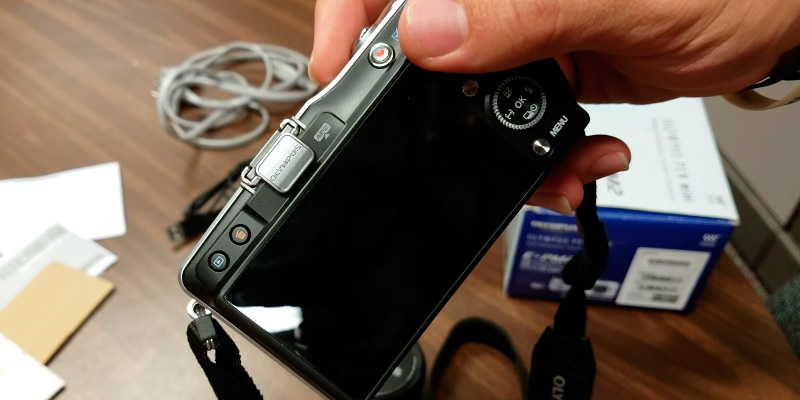
Additional Info
| Last updated price | £399.88 |
| Stock | In stock |
| ASIN | B009C73VW6 |
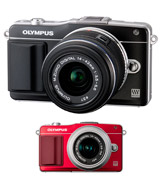
What Is a Mirrorless Camera?
A mirrorless digital camera is yet another step from inexpensive cameras towards the realm of professional photographer equipment and exciting pictures you can take with this equipment. The first significant difference between mirrorless cameras from snapshot cameras is advanced high-resolution image sensors used, which are comparable in terms of performance with those of entry-level digital single-lens reflex (DSLR) cameras. The second distinguishing feature is the design that allows changing lenses on such digital cameras. Also, as the name suggests mirrorless cameras are not equipped with systems of mirrors and optical viewfinders.
In addition, digital mirrorless cameras are more ergonomic and boast a “hot shoe” feature, which is a special port that enables connection of auxiliary equipment: microphone, speedlight, viewfinder, etc. These features really enable you to make photos that are superior quality-wise to those taken with point and shoot cameras, especially when using an appropriate lens on a mirrorless camera.
In what follows is the examination of the parameters and features, which you should closely regard when choosing a mirrorless digital camera. If you happen to be looking for a compact camera, which offers an advanced zooming, we suggest reading our digital point-and-shoot cameras and bridge cameras reviews.
What Features to Compare
Image Quality
To put it simple after you activate a digital camera shutter it is a camera image sensor that forms a resulting image by getting exposed to the light flux that went through the camera lens, in these conditions the image quality is defined to a large extent by the image sensor size. It so happened that image sensors for mirrorless cameras may differ in size by a fraction of a millimeter, thus it was decided to classify these sensors as APS-C for convenience. Thence the presence of this abbreviation in certain camera specifications suggests that the image sensor of the camera has a size within the range from 21.5 x 14.4 mm to 23.5 x 15.6 mm, which far exceeds the average size of an image sensor of a point and shoot camera that in its turn is limited to 1/2.3” or 6.2 x 4.6 mm as a rule.
Another image quality-relating point of mirrorless cameras we advise you to clarify is the sensitivity to light (measured according to an ISO standard) or the exposure index. This sensitivity to light is expressed in an electric signal level generated on a sensor output in response to its absorbing a certain portion of light. Usually, a camera is designed so that its parameters for interpreting the sensor data values into a color space (sRGB) values are fixed, and several different sensitivity selections are accommodated by varying the sensor's electric signal gain in the analog domain, prior to its digitalization. However, there are mirrorless camera designs that provide at least some of exposure index (sensitivity) value choices by adjusting the sensor's signal gain in the digital domain. With that the modern mirrorless digital cameras support a range of light sensitivity values conforming to a corresponding ISO standard. The difference between the sensitivity values is that, for example, selecting an ISO 6400 mode results in a much brighter image than an ISO 400. However, the brighter image obtained will have its downsides, such as image grainy artifacts (so-called “noise”). All in all, you have to keep in mind that the bigger the upper sensitivity value supported by the camera the better overall image quality you’ll get for high-sensitivity ISO regulated modes. In other words, a mirrorless digital camera with a maximum exposure index of 51200 has a better ability to suppress image noise in general than a competing device with 25600 maximum exposure index. While the sensitivity is closely connected with the imaging and image sensor used the sensor size governs a resulting picture and footage resolution in an even more strict way. Whence the difference in resolution of still images taken may not be that obvious the difference in resolution of video footages shot with different sensors is much more conspicuous. Some mirrorless digital camera models are capable of shooting at the Ultra HD (4K) resolution, which uses four times as many pixels as conventional Full HD format. That is why we recommend the owners of 4K TVs and displays to look toward 4K cameras.
Lens Parameters
As we already mentioned the mirrorless camera design allows for lens interchange, thus the lens itself is of a great importance as it directly influences both quality and the overall composition of a picture. Speaking of lenses, one of the key parameters is its focal length, which determines the maximal and minimal distance from the closer lens to an image sensor. Tersely speaking focal length represents zooming capability, since adjusting a focal length, in essence, leads to the adjustment of subject magnification. Today the majority of mirrorless digital cameras produced are equipped with 18-55 mm lenses, which is considered most versatile and suitable for the vast majority of amateurs. After you get more or less familiarized with using your mirrorless camera you can proceed in experimenting with interchangeable lenses intended for certain tasks.
The next important aspect of a mirrorless digital camera we would like to point to is a camera diaphragm. The size of a diaphragm aperture determines the light flux, which an image sensor is exposed to. This size is classified as the “f” value. Please notice that the lesser the f value is the bigger portion of light the sensor is exposed to. Therefore, for example, a lens with f/4-5.6 diaphragm lets through less light than a lens with the f/3.5-5.6 diaphragm. Another plus of interchangeable lenses is that they permit you to focus your camera manually. With this feature, you are free to focus on any object among those you pointed your lens at without the need of waiting for an autofocus to trigger. An interchangeable lens also provides such a beneficial feature as a built-in image stabilization technology (optical stabilization), which is intended to compensate for a camera vertical and horizontal trembling using a special dedicated lens group.
Convenience and Additional Features
The most prominent of these features is probably the ability to attach additional accessories provided by the implementation of a so-called hot shoe. This special port allows for hooking up a digital viewfinder, an advanced flashlight or an additional stereo microphone with an improved background noise suppression. Taken all round this port enables a significant extension and improvement of functionality of your mirrorless interchangeable lens camera. Another feature that greatly facilitates a camera use is a tilting display. A tilting display is really a must for taking pictures of your favorite performing musicians onstage because lifting your camera up, lowering it or taking pictures of flowers, pets or different insects is easily achievable without squatting or jumping. Complementary to hardware features many entry-level mirrorless cameras offer various software features, such as additional shooting modes, special image filters, and wireless technologies. Wireless technologies support provides quick files transfer to any compatible smart device as well as remote camera control using a specialized application after installing it on a tablet PC or a smartphone.
FAQ:
Q: What is the best mirrorless camera for an amateur?
A: We're afraid this is one of those questions that can't be answered in a single sentence and we cannot suggest you a single specific model. The main question is what price are you willing to pay for the device and is your level of proficiency high enough in order to justify purchasing a professional or even a semi-professional camera. The best way to make the right decision is to pay attention to the price/quality balance. Watch all of the chosen device's specs and then compare it with its price. It might take you some time before you find your appropriate model but when you finally find it, you'll be able to enjoy shooting with your brand-new camera.
Q: How can I choose the lenses for my camera?
A: There's no need to buy a large number of lenses, especially if you're not a professional, but the more items you have in your possession, the more diversity you will have, so the probability to choose the appropriate one increases. Make sure the class of the desirable lenses is appropriate for the shooting style you chose. For instance, if you mostly shoot landscapes, you shouldn't buy the lenses that are more appropriate for portraits shooting. Also, purchasing lenses for the brand-new device, it's important to remember that the size of the sensor affects the angle of view, thus influencing the end result of your photos. As you enter the world of removable lenses, you can rummage deep into research with stuff like optical design, the number of aperture blades, lens coatings, and all that other good stuff that makes costly lenses so, well, expensive.
Q: What is a viewfinder?
A: Viewfinder is an auxiliary device of a camera which serves to monitor the shooting subject and determine the boundaries of the shot. Some types of the viewfinder are also used for image quality control, mainly for focusing.
Q: How does mirrorless camera autofocus work?
A: DSLR cameras use the phase detection to focus on an object, but mirrorless cameras use contrast detection. Contrast autofocus works this way: the processor measures the histogram obtained from the camera's matrix, slightly moves the lens (shifting the focus point), then re-measures to see if the contrast has increased or decreased. If the contrast has increased, the camera continues to shift the focus point in the selected direction until the image becomes the most contrast it could possibly be. If the contrast has decreased, the lens has to move the focus point to the other side. The process is repeated until the maximum contrast is reached. Contrast autofocus measures an image (used as a sensor and coinciding with the focus point selected by the photographer) from a small area of the matrix. This allows it to select the object for you to focus on and eliminate the camera's processor from having to measure the contrast of the entire image, thus, it measures the contrast only at selected autofocus points.
Sources:
1. How to choose a mirrorless camera, Walmart.
2. Amadou Diallo Five Reasons Your Next Camera Should Be Mirrorless, Forbes. November 24, 2014.
3. Eric Reichbaum Mirrorless Cameras: A Buying Guide, B&H. 2014.
4. Eric Angevine Mirrorless camera buying guide, Crutchfield. September 1, 2016.
5. Canon EOS M3 review, Trusted Reviews.
6. Dan Bracaglia, Richard Butler, Rishi Sanyal, Carey Rose, Samuel Spencer 2016 Roundup: Interchangeable Lens Cameras $500-800, Digital Photography Review. May 9, 2016.
7. Richard Baguley DSLR vs. Mirrorless Cameras: Which Is Better for You? Tom's Guide. April 21, 2016.
Popular Comparisons
































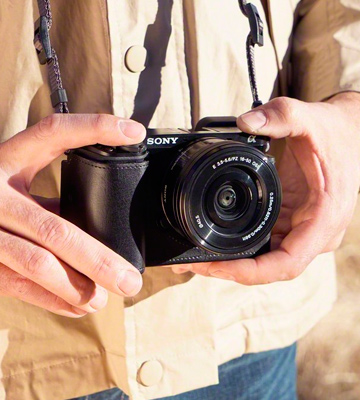

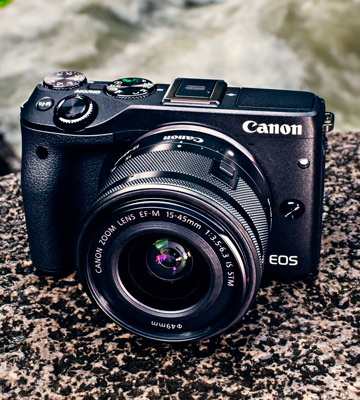

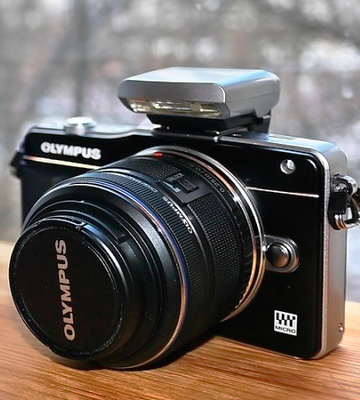
Your comment was successfully sent
Error! Please try again later